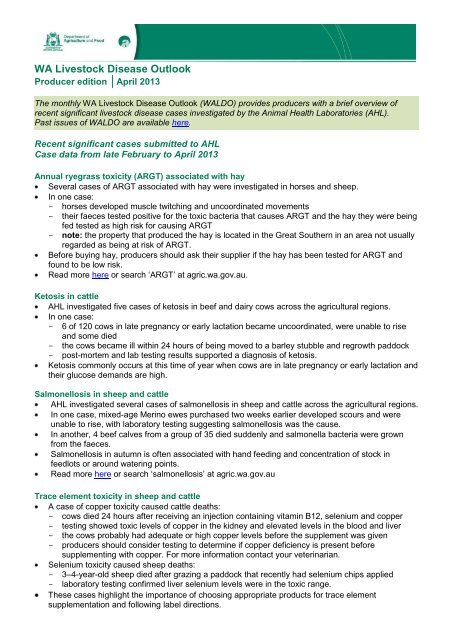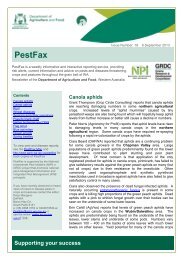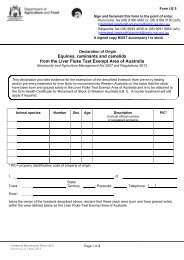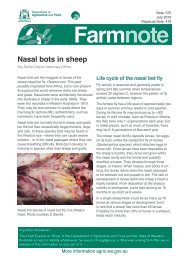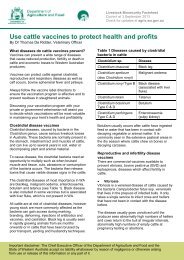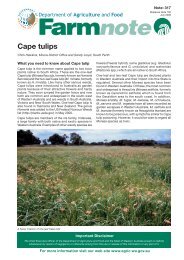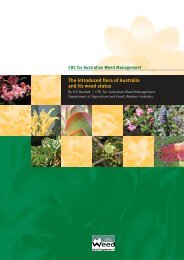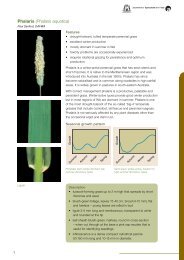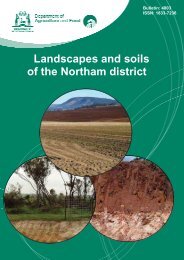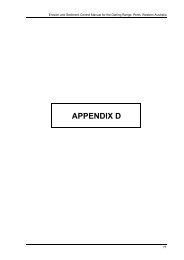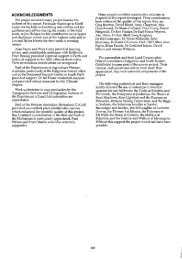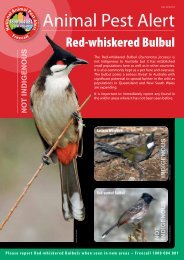WA Livestock Disease Outlook - April 2013 - Agric.wa.gov.au
WA Livestock Disease Outlook - April 2013 - Agric.wa.gov.au
WA Livestock Disease Outlook - April 2013 - Agric.wa.gov.au
Create successful ePaper yourself
Turn your PDF publications into a flip-book with our unique Google optimized e-Paper software.
<strong>WA</strong> <strong>Livestock</strong> <strong>Disease</strong> <strong>Outlook</strong><br />
Producer edition │<strong>April</strong> <strong>2013</strong><br />
The monthly <strong>WA</strong> <strong>Livestock</strong> <strong>Disease</strong> <strong>Outlook</strong> (<strong>WA</strong>LDO) provides producers with a brief overview of<br />
recent significant livestock disease cases investigated by the Animal Health Laboratories (AHL).<br />
Past issues of <strong>WA</strong>LDO are available here.<br />
Recent significant cases submitted to AHL<br />
Case data from late February to <strong>April</strong> <strong>2013</strong><br />
Annual ryegrass toxicity (ARGT) associated with hay<br />
Several cases of ARGT associated with hay were investigated in horses and sheep.<br />
In one case:<br />
- horses developed muscle twitching and uncoordinated movements<br />
- their faeces tested positive for the toxic bacteria that c<strong>au</strong>ses ARGT and the hay they were being<br />
fed tested as high risk for c<strong>au</strong>sing ARGT<br />
- note: the property that produced the hay is located in the Great Southern in an area not usually<br />
regarded as being at risk of ARGT.<br />
Before buying hay, producers should ask their supplier if the hay has been tested for ARGT and<br />
found to be low risk.<br />
Read more here or search ‘ARGT’ at agric.<strong>wa</strong>.<strong>gov</strong>.<strong>au</strong>.<br />
Ketosis in cattle<br />
AHL investigated five cases of ketosis in beef and dairy cows across the agricultural regions.<br />
In one case:<br />
- 6 of 120 cows in late pregnancy or early lactation became uncoordinated, were unable to rise<br />
and some died<br />
- the cows became ill within 24 hours of being moved to a barley stubble and regrowth paddock<br />
- post-mortem and lab testing results supported a diagnosis of ketosis.<br />
Ketosis commonly occurs at this time of year when cows are in late pregnancy or early lactation and<br />
their glucose demands are high.<br />
Salmonellosis in sheep and cattle<br />
AHL investigated several cases of salmonellosis in sheep and cattle across the agricultural regions.<br />
In one case, mixed-age Merino ewes purchased two weeks earlier developed scours and were<br />
unable to rise, with laboratory testing suggesting salmonellosis <strong>wa</strong>s the c<strong>au</strong>se.<br />
In another, 4 beef calves from a group of 35 died suddenly and salmonella bacteria were grown<br />
from the faeces.<br />
Salmonellosis in <strong>au</strong>tumn is often associated with hand feeding and concentration of stock in<br />
feedlots or around <strong>wa</strong>tering points.<br />
Read more here or search ‘salmonellosis’ at agric.<strong>wa</strong>.<strong>gov</strong>.<strong>au</strong><br />
Trace element toxicity in sheep and cattle<br />
A case of copper toxicity c<strong>au</strong>sed cattle deaths:<br />
- cows died 24 hours after receiving an injection containing vitamin B12, selenium and copper<br />
- testing showed toxic levels of copper in the kidney and elevated levels in the blood and liver<br />
- the cows probably had adequate or high copper levels before the supplement <strong>wa</strong>s given<br />
- producers should consider testing to determine if copper deficiency is present before<br />
supplementing with copper. For more information contact your veterinarian.<br />
Selenium toxicity c<strong>au</strong>sed sheep deaths:<br />
- 3–4-year-old sheep died after grazing a paddock that recently had selenium chips applied<br />
- laboratory testing confirmed liver selenium levels were in the toxic range.<br />
These cases highlight the importance of choosing appropriate products for trace element<br />
supplementation and following label directions.
In late <strong>au</strong>tumn be on the lookout for...<br />
<strong>Disease</strong><br />
Pregnancy toxaemia in<br />
ewes<br />
Hypocalcaemia<br />
in ewes<br />
Salmonellosis<br />
Calf scours<br />
Usually affects late-pregnant ewes.<br />
Typical history and signs<br />
Affected ewes typically separate from the flock and appear blind.<br />
Over a few days they lie down, develop muscle twitching and die.<br />
Read more here or search ‘pregnancy toxaemia’ at agric.<strong>wa</strong>.<strong>gov</strong>.<strong>au</strong><br />
Usually affects ewes in late pregnancy or early lactation, often after stressful<br />
events.<br />
May be seen in sheep grazing cereal regrowth or high oxalate pastures.<br />
Typically c<strong>au</strong>ses sudden onset uncoordinated gait with muscle tremors and<br />
death within 24 hours.<br />
Read more here or search ‘hypocalcaemia’ at agric.<strong>wa</strong>.<strong>gov</strong>.<strong>au</strong><br />
Most common in intensively farmed livestock.<br />
C<strong>au</strong>ses profuse diarrhoea. Sheep may be found dead and pregnant ewes may<br />
abort.<br />
Stress and high stocking density are common precursors to an outbreak.<br />
Read more here or search ‘salmonellosis’ at agric.<strong>wa</strong>.<strong>gov</strong>.<strong>au</strong><br />
Typically affects young calves in late <strong>au</strong>tumn and early winter.<br />
Commonly c<strong>au</strong>sed by viruses (e.g. rotavirus), protozoa (e.g. cryptosporidium)<br />
or bacteria (e.g. salmonella or E. coli).<br />
Calves can quickly dehydrate so it is important to provide supportive care.<br />
Read more here or search ‘calf scours’ at agric.<strong>wa</strong>.<strong>gov</strong>.<strong>au</strong><br />
For more information about these diseases, contact your private veterinarian or local Department of<br />
<strong>Agric</strong>ulture and Food (DAF<strong>WA</strong>) veterinary officer.<br />
If you notice any unusual signs of disease in your stock or have unexpected stock deaths, contact your<br />
private veterinarian, local DAF<strong>WA</strong> veterinary officer or phone the Emergency Animal <strong>Disease</strong> hotline on<br />
1800 675 888.<br />
Would you recognise foot-and-mouth disease in your cattle?<br />
Australia has not had an outbreak of foot-and-mouth disease (FMD) for over 100 years, but it is<br />
important we do not become complacent. Farmers and all other people who work with livestock need to<br />
know what FMD looks like and report any suspect animals immediately.<br />
Signs of FMD in cattle include:<br />
severe depression, lack of appetite<br />
a sudden drop in milk yield<br />
sudden death in young calves<br />
reluctance to move progressing to severe lameness<br />
copious drooling and lip smacking<br />
blisters may be visible in the mouth and on the lips and around the top of the foot but are often not<br />
obvious until they rupture.<br />
If you suspect FMD, immediately contact your veterinarian, local DAF<strong>WA</strong> veterinary officer or phone<br />
the Emergency Animal <strong>Disease</strong> hotline on 1800 675 888. The faster the disease is detected, the faster<br />
it can be eradicated and the lower the social and economic impact of the disease.<br />
For more information on FMD click here or search ‘FMD’ at agric.<strong>wa</strong>.<strong>gov</strong>.<strong>au</strong><br />
DAF<strong>WA</strong> welcomes your feedback on <strong>WA</strong>LDO. Please provide comments to katie.webb@agric.<strong>wa</strong>.<strong>gov</strong>.<strong>au</strong>.<br />
Disclaimer: The Chief Executive Officer of the Department of <strong>Agric</strong>ulture and Food and the State of Western<br />
Australia accept no responsibility whatsoever by reason of negligence or otherwise arising from the use or<br />
release of this information or any part of it.


